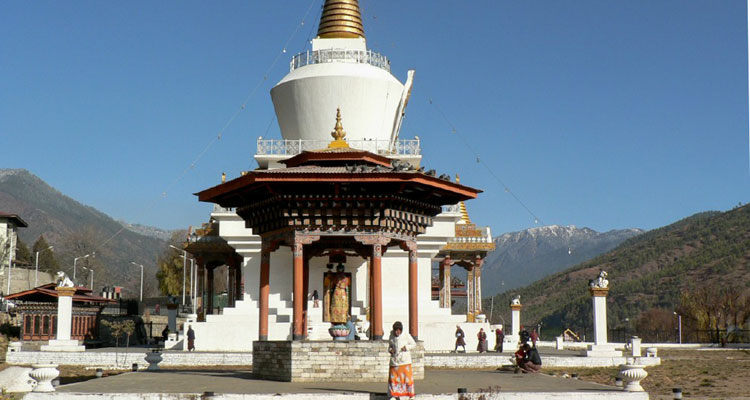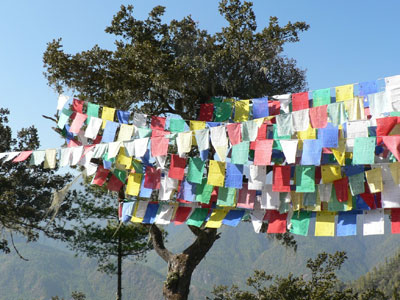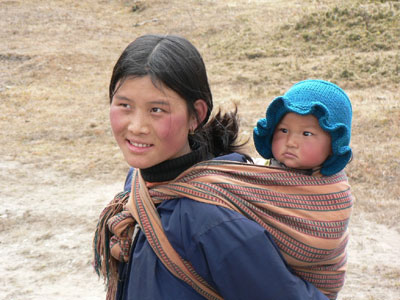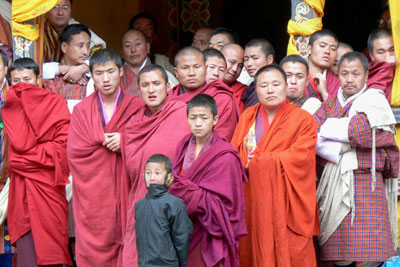Beguiling Bhutan
by Sondra Markman, Edison, NJ
Bhutan is a small, landlocked country bordered by China and India. There is only one airline, Druk Air (phone +975 8 271856), with two planes to get you there and seven pilots and 10 copilots trained to make the tricky landing at Paro Airport, the only airport in the country. So why go through the effort of traveling so far for a stay in such a small country? Visitors willing to take the long journey will be rewarded with experiences that will be remembered long afterward.
Planning a visit
We were told that the philosophy of tourism in Bhutan is “high value, low volume.” Except for residents of India, who have a special arrangement, visitors must pay a daily rate ($250 per person at the time of our visit), which covers an English-speaking guide as well as a driver, a vehicle, accommodations, meals and entry fees.
Although there are independent travel agents, the government sets the daily rate based on the number of people traveling together. Since there were two couples in our party, we experienced a savings, paying $200 per person.
Fortunately, many travel agents in Bhutan speak English and have Internet access. We arranged the whole trip from home by e-mail, wire transferring the funds. Our agent at Snow Leopard Trekking Company (Thimphu, Bhutan; phone +975 2 321821) suggested an itinerary, then modified it to suit our preferences.
Of course, there are package tours to the same places sold in the United States, but they were more expensive than booking on our own.
Our trip cost $4,400 per person for 13 nights in Bhutan and three nights in Bangkok (at the beginning and end of the trip), including airfare from New York City. Our agent handled our visa applications.
We settled on a cultural tour with time for hiking and bird-watching along the way. On one hike, we were fortunate to get a close look at many black-necked cranes, a protected species, that were wintering in the Phobjikha Valley.
Culture and religion
We planned the trip so we could attend one of the colorful festivals held throughout the country. Yearly schedules, available on various sites online (including www.visitingbhutan.com/bhutanfestival2012.php), give the locations and dates. We selected the Trongsa festival, which took place in late December ’10 in the courtyard of a large dzong, or fortress.
Dancers wore lavish costumes and headdresses or masks, and musicians played instruments we did not recognize. Clowns, called atsaras, roamed through the crowd to entertain and keep order. Our eyes darted from the performers to the audience, dressed in their finery. (People are required to wear the national dress for these special occasions as well as at work and in school.)
On the last morning of the festival, we witnessed a musical procession in which a thongdrel, a huge embroidered thangka (scroll painting), is carried in by monks and raised along one wall of the courtyard. It is displayed for only a few hours each year. People attend this display to pay homage and receive the sacred thongdrel’s blessings.
During our visit we were immersed in the Buddhist culture of the country and learned about the customs practiced in Bhutan. As we visited various sites, we learned about the traditions and the deities, demons and demonesses. We saw prayer wheels of varying sizes that have prayers rolled up inside, from a whole row of wheels in a monastery to one that was handheld. Every time people turn the wheels, it is as if they are saying the prayers.
Impressions
Bhutan is a country without traffic lights. We were told that they tried one in Thimphu, the capital city, but it didn’t work out. Instead, there is a booth with a uniformed man directing traffic with graceful arm motions. There are no superhighways.
Our driver was experienced at navigating the mountain roads, which often were rather narrow. Traveling east to the more remote sections of the country took time, yet it was a memorable journey.
The scenery was incredible, with waterfalls, terraced farms, homes in the prescribed style, and prayer flags blowing in the wind. We saw yaks by the roadside and stopped to watch gray langur monkeys at play.
We had the opportunity to spend a couple of days with an American woman who has lived in Bhutan for 24 years. Despite the hardship of having no central heating and the need to go elsewhere for surgery, she has found a way of life that is satisfying and uplifting.
We saw the altar in her shrine room, common in most Buddhist households, and there was an incense burner and a prayer wheel outside. Our new friend exuded a goodness and warmth that was so refreshing.
There are no fast-food restaurants, and very few establishments take credit cards. ATM machines? Forget it!
Tourism Council of Bhutan (includes links to local tour operators)
Kuensel Online (daily newspaper)
Gross National Happiness info
Recommended reading
Beyond the Sky and the Earth by Jamie Zeppa
The Circle of Karma by Kunzang Choden
Bhutan Travel Guide (third edition, April 2007), Lonely Planet
Recommended movie
Travellers and Magicians
Not all sections of the country have electricity. We had wood stoves in a couple of the hotels.
Is change coming? There are signs that it is. People have television sets, and there is Internet access in cafés, offices and colleges, though, so far, it is not common for an individual family to have a computer at home. Cell phones, however, are widespread.
Bhutan is known for its tenet of Gross National Happiness (GNH), designed to improve life for its people. The model is based on the four pillars of sustainable economic development; environmental conservation; preservation of culture, and good governance. It may not be paradise — for example, we did hear about some problems with drugs and saw signs about preventing the spread of aids — but it is clear that there are national aspirations.
Is Bhutan really the mysterious Shangri-La? Probably not, yet it is haunting.
After the four of us returned, my friend said to me, “My body is back home, but my head is still in Bhutan.”




